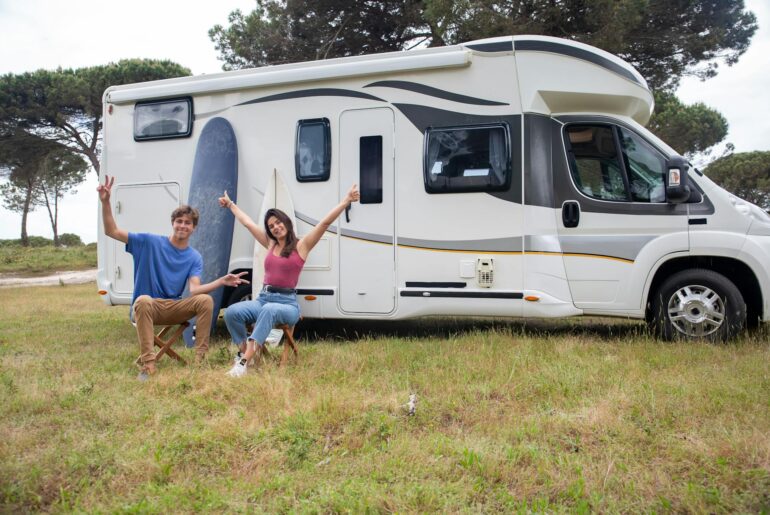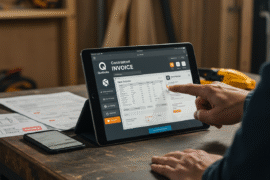This article may contain references to products or services from one or more of our advertisers or partners. We may receive compensation when you click on links to those products or services. Nonetheless, our opinions are our own.
The information presented in this article is accurate to the best of our knowledge at the time of publication. However, information is subject to change, and no guarantees are made about the continued accuracy or completeness of this content after its publication date.
- Shop Around Before Choosing RV Financing
- Review Your Credit Score First
- Evaluate Loan Terms Carefully
- Include All RV-Related Costs in Your Budget
- Consider Refinancing Options
- RV Finance Rates Explained
- Factors That Affect RV Loan Rates
- How Credit Scores Affect Your RV Loan
- Steps to Prepare for an RV Loan
- RV Financing Basics
- Steps to Get the Best RV Loan Rate
- How to Negotiate a Better RV Loan
- What to Know About Dealer Financing
- Tips to Lower Your Interest Rate
- Final Thoughts on RV Loan Interest Rates
- Frequently Asked Questions
- Recommended Reads
Shop Around Before Choosing RV Financing
Shopping around for RV financing allows you to compare offers from banks, credit unions, and online lenders. Each lender may have different qualification requirements, interest rates, fees, and repayment terms. By requesting quotes from multiple providers, you gain a clearer picture of what your monthly payments will look like and how much the loan will cost over time. This step helps ensure you get the most competitive deal available for your credit profile and budget.
Review Your Credit Score First
Before applying for an RV loan, it’s important to review your credit score and address any issues. Your credit score is one of the primary factors lenders use to determine interest rates and loan approval. A high score may help you qualify for lower rates, saving thousands of dollars in interest over the life of the loan. If your score needs improvement, consider taking a few months to pay down debt, correct errors on your credit report, and avoid opening new credit lines before applying.
Evaluate Loan Terms Carefully
Loan terms significantly impact both your monthly payment and the total cost of borrowing. A longer loan term, such as 15 or 20 years, can make payments more manageable each month, but you’ll pay more in interest overall. On the other hand, shorter loan terms usually carry lower interest rates and less total interest paid but come with higher monthly payments. It’s important to weigh these trade-offs based on your financial situation and how long you plan to keep the RV.
When budgeting for your RV purchase, remember that the loan payment is just one piece of the puzzle. You’ll also need to factor in insurance, fuel, maintenance, storage fees, and campground costs. Some RVs require winterizing or have specialized repair needs that can add up. Creating a comprehensive budget that includes both upfront and ongoing costs helps prevent financial strain and ensures that you can enjoy your RV without unexpected expenses.
Consider Refinancing Options
If you’ve already taken out an RV loan but are unhappy with your rate or payment terms, refinancing may be a smart move. Refinancing involves taking out a new loan to replace your current one, ideally with a lower interest rate or better repayment terms. This can reduce your monthly payments or the total interest you’ll pay. However, be sure to review any fees or penalties for early repayment of your current loan, and ensure that the savings from refinancing outweigh the costs.
RV Finance Rates Explained
RV loans are structured similarly to auto loans but often come with longer repayment periods and higher interest rates. This is because RVs are considered luxury or recreational items, making them a higher risk for lenders. Loan terms can stretch up to 20 years, and interest rates may vary widely depending on the borrower’s credit profile, the RV’s age and type, and the loan amount. Understanding how these factors interact helps you select a financing plan that fits your long-term financial goals.
Voted "Best Overall Budgeting App" by Forbes and WSJ
Monarch Money helps you budget, track spending, set goals, and plan your financial future—all in one app.
Get 50% OFF your first year with code MONARCHVIP
Factors That Affect RV Loan Rates
Lenders consider several elements when determining your RV loan’s annual percentage rate (APR). Your credit score is one of the most important—borrowers with excellent credit can often access significantly better rates. The loan term also plays a role: shorter terms usually mean lower interest rates, while longer terms increase risk and therefore cost. Additionally, newer RVs typically qualify for lower rates than older models. The total loan amount can also influence the rate, as lenders may see larger loans as higher risk.
How Credit Scores Affect Your RV Loan
Your credit score is a snapshot of your financial reliability and repayment history. A higher score signals to lenders that you are a low-risk borrower, which can lead to better interest rates, higher loan limits, and more favorable loan terms. If your credit is fair or poor, you may still qualify, but with a higher interest rate. To improve your chances of approval, pay down existing debts, avoid missed payments, and check your credit reports for inaccuracies before you apply.
Steps to Prepare for an RV Loan
Taking time to prepare before applying for RV financing can make the process smoother and help you get the best deal. Begin by gathering documents such as proof of income, recent tax returns, and your ID. You should also obtain a copy of your credit report to see where you stand and correct any errors. Additionally, assess how much you can afford by reviewing your debt-to-income ratio and setting a realistic monthly payment limit that fits your overall budget.
Documents You’ll Need
Lenders require several documents to assess your financial status and confirm your identity. This typically includes recent pay stubs or tax returns to verify income, your credit report, and personal identification like a driver’s license and proof of address. Having these ready ahead of time can speed up the approval process and show lenders that you’re a serious and prepared applicant.
Assess Your Financial Stability
Before committing to a loan, take a deep look at your finances. Calculate your debt-to-income (DTI) ratio to ensure you meet lender requirements, typically under 40%. Make a detailed monthly budget that includes the RV payment, insurance, and expected maintenance. This ensures that the RV loan won’t overextend your finances and gives you confidence in your ability to repay the loan on time.
RV Financing Basics
If you’re new to RV loans, understanding the basic steps will help you navigate the process more confidently. First, gather all necessary documents and check your credit report for accuracy. Decide how much you’re willing to borrow and what kind of RV fits within your budget. Then, shop around to compare rates from credit unions, banks, and online lenders. Being informed helps you make better choices and avoid loans that are too expensive or restrictive.
Get Ready with the Right Information
Make sure to collect income verification, a valid ID, and specifics about the RV you want to buy. Review your credit report for any issues that may affect your application. Knowing your financial standing and RV details helps you get accurate loan quotes and avoids delays during approval.
Explore Your Loan Options
There are several types of lenders who offer RV financing, including credit unions known for low rates, online lenders with fast approvals, and traditional banks with dedicated loan products. Each has different approval processes, interest rates, and loan structures. Take time to compare all options and read the fine print on fees and prepayment penalties.
Steps to Get the Best RV Loan Rate
Step 1: Research Lenders
Start by identifying reputable lenders who specialize in RV financing. Look at both national institutions and local credit unions. Read customer reviews and check ratings to gauge service quality and transparency. Specialized RV lenders often provide better terms than general banks, especially for unique models or higher-value rigs.
Step 2: Compare Offers
Contact multiple lenders and request loan quotes to compare the following:
- Annual Percentage Rate (APR)
- Loan term (number of years)
- Monthly payments
- Any origination or processing fees
| Lender | Loan Amount | APR | Loan Term (Years) | Monthly Payment |
|---|---|---|---|---|
| Lender A | $50,000 | 7.5% | 15 | $446 |
| Lender B | $50,000 | 8.0% | 20 | $405 |
| Lender C | $50,000 | 7.25% | 15 | $438 |
Comparing these side-by-side helps you find the best long-term value for your budget and credit profile.
Step 3: Pre-qualify and Submit Your Application
Many lenders offer pre-qualification, letting you see estimated terms without a hard credit inquiry. This is a great way to shop rates safely. Once you choose a lender, complete the application and submit the required documents. If approved, you’ll receive the final loan agreement with full terms for review and signature.
How to Negotiate a Better RV Loan
Don’t accept the first offer you receive. use your research to negotiate better terms. Lenders may be willing to match or beat competing offers, especially if you have a strong credit profile. Emphasize your income stability, creditworthiness, and the size of your down payment. If the terms are not ideal, don’t hesitate to walk away and explore other options. Being assertive could save you hundreds or even thousands over the life of the loan.
What to Know About Dealer Financing
RV dealerships often promote in-house financing to simplify the purchase process. However, these loans may include higher interest rates or hidden fees, since dealers may earn commissions from financing partners. While convenient, it’s best to treat dealer financing as one of several options. Always compare it to external lenders and verify that the APR and terms align with your financial needs before signing.
Tips to Lower Your Interest Rate
If you want a lower interest rate, take proactive steps before applying. Raising your credit score by reducing debt and paying bills on time is one of the most effective ways to qualify for better rates. Making a larger down payment reduces the lender’s risk and could improve your loan terms. You might also consider applying with a co-signer or using a secured loan backed by other assets, which can result in a more favorable APR.
Final Thoughts on RV Loan Interest Rates
Finding the best RV loan rate involves more than just accepting the first offer. From checking your credit to comparing multiple lenders and negotiating terms, every step plays a role in the final outcome. Be realistic about what you can afford and don’t overlook additional costs like insurance and maintenance. With the right planning and a clear understanding of your options, you can secure a financing deal that supports your RV ownership goals without overburdening your finances.
Frequently Asked Questions
What is a good interest rate for an rv loan?
A good rv loan rate typically falls below 8% for borrowers with excellent credit. However, rates vary based on market conditions, the type of rv, and your financial history. People with strong credit scores and steady income often qualify for the lowest rates. Always compare offers to ensure you’re getting a competitive deal based on your profile.
Can I refinance my rv loan to get a better rate?
Yes, refinancing your rv loan can be a smart way to lower your monthly payments or reduce the total interest paid. If your credit score has improved since you first got the loan or if interest rates have dropped, you may qualify for better terms. It’s important to check for any fees associated with refinancing and calculate how much you’d actually save over the new loan’s term.
How long can you finance an rv?
Rv loan terms usually range from 5 to 20 years. Shorter terms have higher monthly payments but lower overall interest costs. Longer terms lower the monthly burden but increase total interest paid. Choose a term based on how long you plan to keep the rv and how much you can comfortably afford each month.
Do rv dealers offer the best financing rates?
Not always. While dealers offer convenience by arranging financing on-site, their rates can be inflated due to third-party partnerships or added commissions. Independent lenders like credit unions or online banks may offer more competitive terms. Always compare dealer quotes to other lenders before finalizing any deal.

Reviewed and edited by Albert Fang.
See a typo or want to suggest an edit/revision to the content? Use the contact us form to provide feedback.
At FangWallet, we value editorial integrity and open collaboration in curating quality content for readers to enjoy. Much appreciated for the assist.
Did you like our article and find it insightful? We encourage sharing the article link with family and friends to benefit as well - better yet, sharing on social media. Thank you for the support! 🍉
Article Title: Best RV Loan Rates and How to Qualify
https://fangwallet.com/2025/07/11/best-rv-loan-rates-and-how-to-qualify/The FangWallet Promise
FangWallet is an editorially independent resource - founded on breaking down challenging financial concepts for anyone to understand since 2014. While we adhere to editorial integrity, note that this post may contain references to products from our partners.
The FangWallet promise is always to have your best interest in mind and be transparent and honest about the financial picture.
Become an Insider

Subscribe to get a free daily budget planner printable to help get your money on track!
Make passive money the right way. No spam.
Editorial Disclaimer: The editorial content on this page is not provided by any of the companies mentioned. The opinions expressed here are the author's alone.
The content of this website is for informational purposes only and does not represent investment advice, or an offer or solicitation to buy or sell any security, investment, or product. Investors are encouraged to do their own due diligence, and, if necessary, consult professional advising before making any investment decisions. Investing involves a high degree of risk, and financial losses may occur including the potential loss of principal.
Source Citation References:
+ Inspo
There are no additional citations or references to note for this article at this time.












































